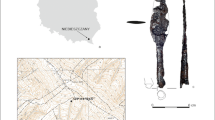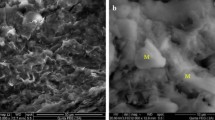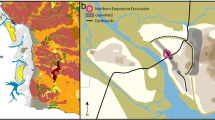Abstract
The analysed samples come from the archaeological rescue digs undertaken on the Iernut-Chețani segment from the Transilvania Highway (Sector 2A Ogra-Câmpia Turzii). The samples were taken from 7 pottery sherds, as well as clay taken from within the dig site. The 7 sherds, dated to the Neolithic period, are different and consist of 4 fine pottery sherds, 1 semifine pottery sherd and 2 coarse. Complementary techniques were used in the analysis, namely TG/HF, FTIR, SEM, EDX and XRD. The purpose of the analysis was to determine similarities between the composition of the pottery sherds, as well as similarities between the pottery composition and the soil samples, in order to determine whether the raw materials used had a local origin. Furthermore, the techniques employed were selected to also help identify the pottery technology (estimating the firing temperatures).











Similar content being viewed by others
References
Ursuțiu A, Cociș S, Stanciu I, Onofrei C, Cristea Ș, Malvinka U, Szabolcs F, 103. Iernut. Mureș County. Site II, km 9+300 - 8+800, Transilvania Highway A3, Sector 2A Ogra-Câmpia Turzii, Iernut-Chețani. Cronica Cercetărilor Arheologice din România – Campania 2016 (The Archaeological Research Chronical of Romani – 2017 Campaign), Institutul Național al Patrimoniului (National Heritage Institute), Bucharest; 2017.
Vlase D, Rogozea O, Moșoiu C, Vlase G, Lazău R, Vlase T. Thermoanalytical investigations of some ceramics dated from the Neolithic period, discovered at Oxamplatz, Sânandrei, Romania. J Therm Anal Calorim. 2019;138:2145–57.
Ghe L. The absolute and relative chronology and evolution of the Zau Culture. Acta Musei Porolissensis. 2012;34:55–71.
Drașovean F. Regarding the relative and absolute chronology of the Neolithic and early Eneolithic in the eastern Carpathian basin. A Bayesian approach. Analele Banatului-Arheologie-Istorie. 2014;22:33–77.
Roberts JP. Determination of the firing temperature of ancient ceramics by measurement of thermal expansion. Archaeometry. 1963;6:21–5.
Drebushchak VA, Mylnikova LN, Drebushchak TN. Thermoanalytical investigations of ancient ceramics. Review on theory and practice. J Therm Anal Calorim. 2018;133:135–76.
Vlase DS, Vlase T, Micle D. FT-IR, TG/DTG/DTA-DSC analysis applied on Ottoman pottery discovered following archaeological rescue excavations in Libertății Square, Timișoara (2013–’14 campaign). ArheoVest. 2015;III–2:831–48.
Anghel D. Experimental contributions regarding methods of use for the different types of neo-eneolithic pottery firing installations. Apulum. 2003;40:523–33.
Anghel D. Pottery degradation as a result of technological deficiencies. Apulum. 2002;39:597–613.
Alaiba RE. Cucuteni culture pottery. Arheol Mold. 2005;28:57–73.
Lazarovici G, Ionescu C, Gherghari L. Ceramic artefacts from the mid Neolithic fom Transylvania: CCTLNI culture from the Zau site (Mureş county). Angvstia. 2002;7:7–18.
Mihăilescu L. Specifics of pottery from south-western Romania, observed in the pottery centers of Sasca Română, Potoc and Socolari (Caraş-Severin county). Studi şi Comunicări-Etnografie şi Istorie. 1975;I:111–23.
Lazarovici G, Traore F. A pottery firing technique used from prehistory to the present day. An ethno-archaeological study. ActaMN. 1989–1993; 26–30 I/2:553–5556.
Orton C, Tyers P, Vince A. Pottery technology. Cambridge: University Press; 1993.
Marian A, Ciută M, Anghel D. Historical considerations regarding a physical chemical analysis of Precriș culture pottery. Sargetia. 2003;31:37–50.
Shoval S, Beck P, Kirsh Y, Levy D, Gaft M, Yadin E. Rehydroxylation of clay minerals and hydration in ancient pottery from the Lasng of Deshur. J Therm Anal Calorim. 1991;37:1579.
Muller CM, Pejcic B, Esteban L, Piane CD, Raven M, Mizaikoff B. Infrared attenuated total reflectance spectroscopy: an innovative strategy for analyzing mineral components in energy relevant systems. Sci Rep. 2014;4:6764.
Palanivel R, Rajesh KU. Thermal and spectroscopic analysis of ancient potteries. Rom J Phys. 2011;56(1–2):195–208.
Shoval S, Beck P. Thermo-FTIR spectroscopy analysis as a method of characterizing ancient ceramic technology. J Therm Anal Calorim. 2005;82:609–16.
El OM, Daoudi L, Hatert F, Fagel N. Modified mineral phases during clay ceramic firing. Clays Clay Miner. 2015;63(5):404–13.
Amicone S, Mathur A, Rengasamy DP, Mirković-Marić N, Pantović I, Kuzmanovic-Cvetkovic J. Beneath the surface: Exploring variability in pottery paste recipes within Vinča culture. Quat Int. 2020;560–561:86–101.
Bate S, Stevens T, Buylaert J-P, Markovic S, Tasić N. Pottery versus sediment: Optically stimulated luminescence dating of the Neolithic Vinča culture, Serbia. Quat Int. 2020;429-A:45–53.
Gajic Kvascev M, Marić Stojanović M, Šmit Ž, Kantarelou V, Karydas A, Šljivar D, Milovanović D, Andrić V. New evidence for the use of cinnabar as a colouring pigment in the Vinča culture. J Archaeol Sci. 2012;2012(39):1025–33.
Jakucs J. LBK and Vinča in South-East Transdanubia: comments on merging, interleaving and diversity. Quat Int. 2020;2020(560–561):119–41.
Predescu S, Cultural heritage: Identity and collective capacity building. In Sava S., Borca C., Clitan Gh. (eds.), Collective Capacity Building. London: Brill/Sense Publishers 2020;35–43. ISBN: 978-90-04-42220-9
Acknowledgements
We would also like to offer our gratitude to M. Răchită, Ph.D. student at Babes-Bolyay University from Cluj-Napoca, for providing the analysed samples, as well as to A. Ursuțiu, Ph.D., from the Archaeology and Art History Institute of Cluj-Napoca, who led the collective that carried out the archaeological excavations at Iernut-Site II, during which the sherds were discovered.
Author information
Authors and Affiliations
Corresponding authors
Additional information
Publisher's Note
Springer Nature remains neutral with regard to jurisdictional claims in published maps and institutional affiliations.
Rights and permissions
About this article
Cite this article
Vlase, D., Vlase, T., Bunoiu, M. et al. Characteristics of late Neolithic pottery of the Zau culture: analysis of pottery samples from Iernut-Site II (Mures County, Romania). J Therm Anal Calorim 147, 5351–5363 (2022). https://doi.org/10.1007/s10973-022-11261-3
Received:
Accepted:
Published:
Issue Date:
DOI: https://doi.org/10.1007/s10973-022-11261-3




